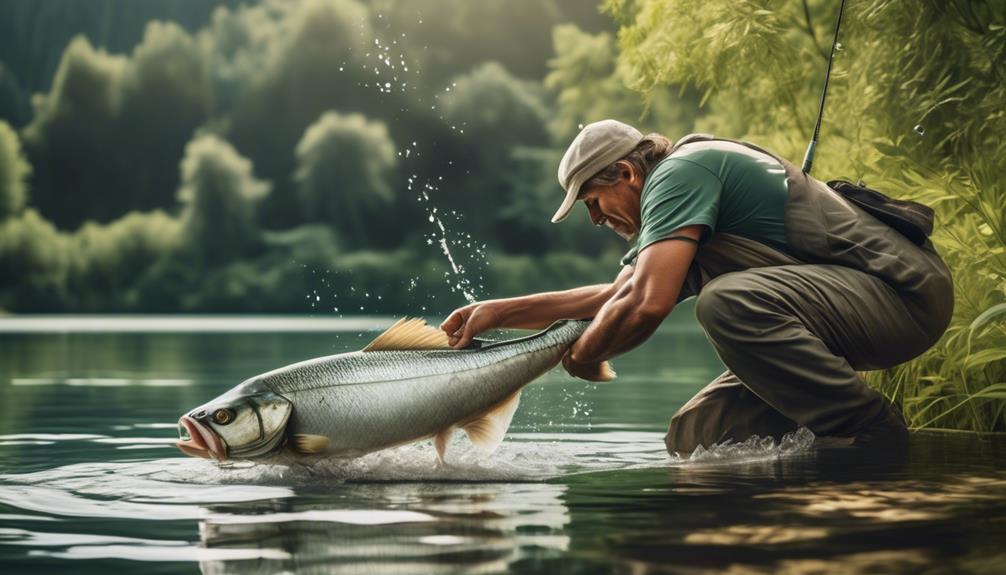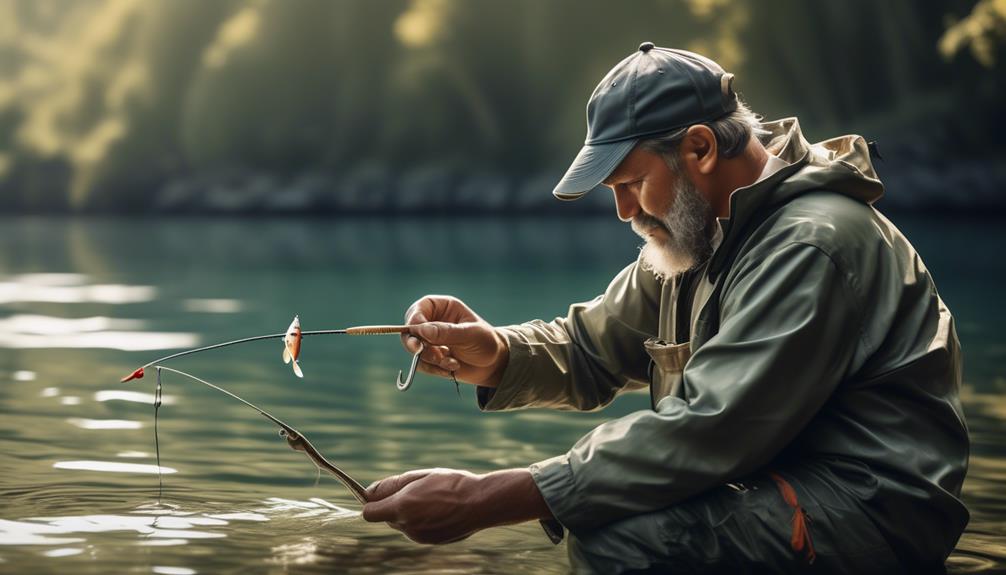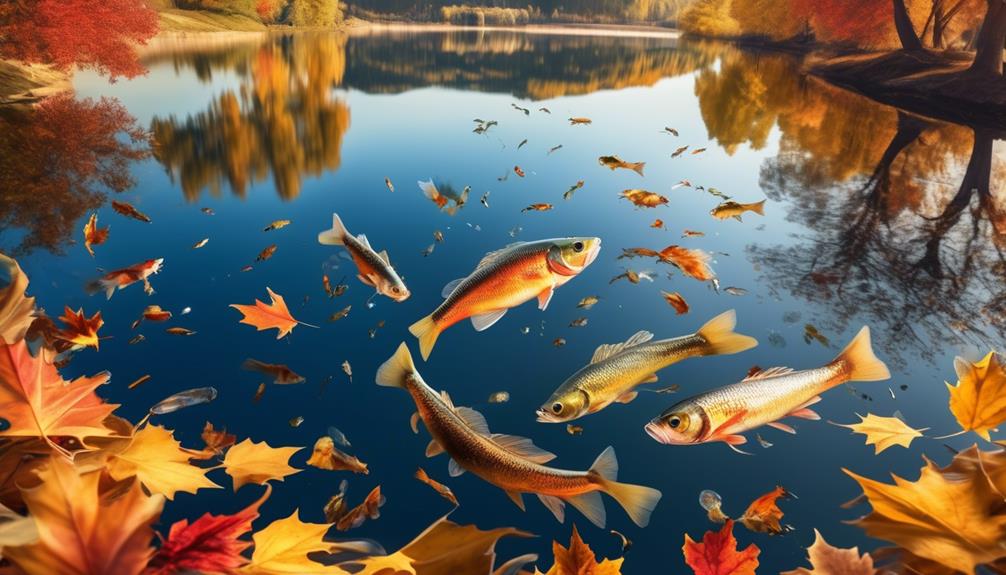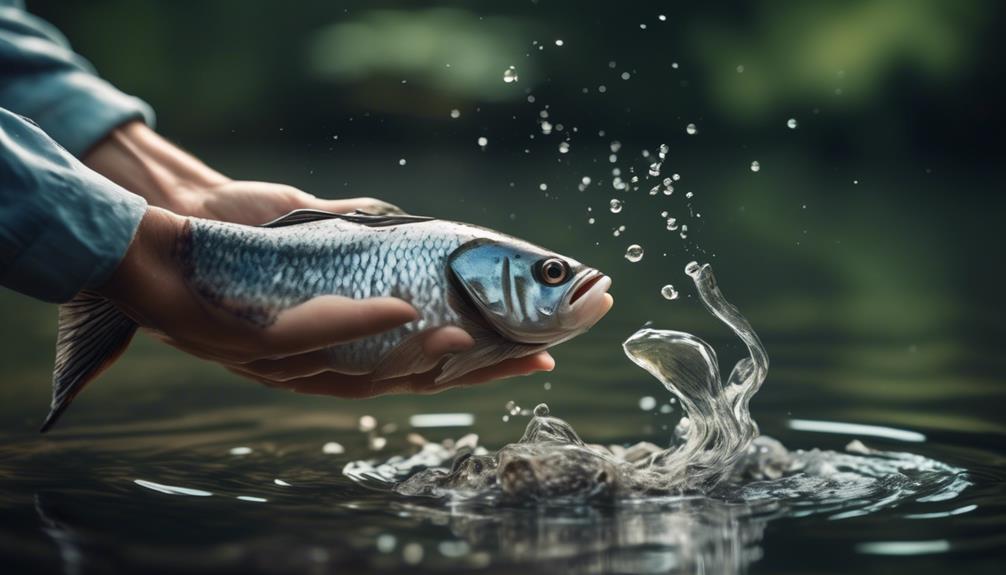Isn't it remarkable how catch and release has become an essential component of ethical fishing tournaments?
As an angler, you may have pondered the significance of this practice, and the implications it holds for the well-being of aquatic ecosystems. Have you ever considered the profound impact that catch and release has on the sustainability of fish populations and the preservation of natural habitats?
You might be surprised to learn how this practice not only benefits the environment but also contributes to the ethical treatment of wildlife and the enhancement of recreational fishing. But what exactly makes catch and release ethical in the context of tournaments?
Preservation of Fish Population
To ensure the preservation of fish population, practicing catch and release in tournaments is essential for maintaining sustainable fishing practices. Fishery management and conservation are crucial for the long-term health of aquatic ecosystems. By releasing fish back into their natural habitat, anglers play a vital role in wildlife sustainability and habitat protection. This practice allows fish populations to remain stable, ensuring that future generations can continue to enjoy the thrill of fishing.
Conservation efforts are at the heart of catch and release practices in tournaments. By releasing fish unharmed, anglers contribute to the overall health and balance of fish populations. This approach aligns with the principles of responsible fishery management, as it helps prevent overfishing and supports the replenishment of fish stocks.
Moreover, engaging in catch and release promotes habitat protection. By allowing fish to return to their natural environment, anglers help maintain the delicate balance of aquatic ecosystems. Healthy fish populations contribute to the overall biodiversity of marine life, fostering a sustainable and thriving environment.
Mitigation of Environmental Impact
By releasing fish unharmed and promoting sustainable fishing practices, anglers actively mitigate their environmental impact on aquatic ecosystems during tournaments. When participating in catch and release tournaments, it's crucial to focus on reducing stress and minimizing harm to the fish population and their habitat. Stress reduction is vital as it helps ensure the survival of the released fish and maintains the overall health of the aquatic environment.
To mitigate environmental impact, anglers should handle fish with care, minimizing the time they're out of the water and using proper techniques for hook removal. By doing so, the stress on the fish is reduced, increasing their chances of survival after release. Additionally, using barbless hooks can minimize harm to fish, making it easier to unhook them and decreasing the risk of injury during the catch and release process.
Furthermore, anglers should be mindful of the areas where they fish, ensuring they leave no waste behind and minimizing any disturbance to the natural habitat. By following sustainable fishing practices and respecting the environment, anglers can actively contribute to the preservation of aquatic ecosystems.
Additionally, promoting the use of non-lead fishing weights can also help to minimize harm to the environment and aquatic life, as lead weights can have detrimental effects on both fish and their habitats.
Promotion of Sustainable Angling
Promote sustainable angling by educating fellow anglers on the importance of conservation and responsible fishing practices. By fostering angler education and environmental responsibility, you can make a significant impact on the preservation of aquatic ecosystems.
Here's how you can promote sustainable angling:
- Educate on Selective Harvest: Encourage fellow anglers to understand the concept of selective harvest, where they only keep a reasonable amount of fish for consumption while releasing the rest. By advocating for this practice, you contribute to maintaining fish populations and preserving the natural balance of aquatic environments.
- Advocate for Proper Handling Techniques: Emphasize the significance of handling fish with care to minimize stress and injury. Teach others about the proper methods for catch and release, such as using barbless hooks, minimizing air exposure, and supporting the fish in the water until it can swim away on its own. This ensures the survival of released fish, contributing to sustainable angling.
- Promote Habitat Conservation: Raise awareness about the impact of angling on the environment and encourage responsible behavior. Highlight the importance of preserving habitats by avoiding damage to aquatic vegetation, respecting protected areas, and disposing of fishing waste properly. By doing so, you contribute to the overall health of aquatic ecosystems.
- Lead by Example: Set a positive precedent by practicing sustainable angling techniques and demonstrating environmental responsibility. By showcasing responsible angling practices, you inspire others to follow suit, perpetuating a culture of conservation within the angling community.
Ethical Treatment of Wildlife
Foster a culture of respect and empathy towards wildlife by prioritizing ethical treatment in all angling practices. When participating in fishing tournaments, it's crucial to uphold animal welfare and adhere to tournament regulations to ensure the ethical treatment of wildlife. Conservation ethics and angler responsibility go hand in hand when it comes to the well-being of the fish and their natural habitat.
In the realm of tournament angling, it's essential to prioritize the ethical treatment of wildlife. This involves following tournament regulations that are designed to protect the fish population and their ecosystem. By adhering to catch and release guidelines, anglers can minimize the impact on fish populations, allowing them to thrive for future generations. Furthermore, handling fish with care, using barbless hooks, and minimizing air exposure are all crucial components of ethical angling practices that contribute to animal welfare.
Conservation ethics play a pivotal role in the ethical treatment of wildlife during angling activities. Anglers have a responsibility to be stewards of the environment, ensuring that their actions don't harm the delicate balance of the ecosystem. Practicing responsible angling techniques, such as proper fish handling and using the right gear, not only promotes conservation but also demonstrates respect for the natural world. By embracing conservation ethics, anglers can contribute to the sustainability of fish populations and their habitats, thus safeguarding the well-being of wildlife for generations to come.
Adherence to Conservation Practices
To ensure the sustainability of fish populations and their habitats, anglers must adhere to conservation practices that minimize their impact on the ecosystem. Adhering to conservation practices is crucial not only for the well-being of the fish but also for the overall health of the aquatic environment.
Here's how you can take responsible steps to contribute to wildlife management and ethical considerations:
- Select Appropriate Fishing Gear: Choose gear that minimizes harm to the fish. Use barbless hooks, which can be removed more easily and cause less damage to the fish.
- Handle Fish with Care: When catching and releasing fish, minimize their time out of the water. Support the fish properly and avoid causing unnecessary stress or injury. This is vital for the fish's survival after release.
- Be Mindful of Habitat: Avoid fishing in areas where fish are spawning or in shallow waters where they may be more vulnerable. By being conscious of the fish's habitat, you contribute to conservation efforts and ensure the sustainability of their populations.
- Educate Others: Share your knowledge and encourage fellow anglers to adopt responsible practices. By spreading awareness, you contribute to angler responsibility and conservation efforts, ultimately playing a part in preserving fish populations for future generations.
Adhering to these practices not only aligns with ethical considerations but also plays a significant role in wildlife management and conservation efforts. By taking these steps, you contribute to the well-being of fish populations and their ecosystems.
Enhancement of Recreational Fishing
Thinking of ways to enhance your recreational fishing experience? Fishery management plays a crucial role in ensuring a sustainable and enjoyable fishing environment. By actively participating in fishery management efforts, anglers can contribute to the enhancement of recreational fishing.
One way to do this is by staying informed about local fishery regulations and restrictions. Understanding and following these regulations demonstrate angler responsibility and contribute to the conservation of fish populations.
Additionally, engaging in catch and release practices can significantly enhance recreational fishing. When practiced responsibly, catch and release allows for the conservation of fish stocks, ensuring that future generations of anglers can continue to enjoy the sport. It's important to handle fish with care, using barbless hooks and minimizing air exposure to increase their chances of survival upon release.
Furthermore, anglers can enhance their fishing experience by actively participating in habitat restoration and clean-up efforts. By volunteering for local conservation organizations or participating in clean-up events, you can directly contribute to the improvement of aquatic ecosystems, creating better fishing opportunities for yourself and others.
Respect for Natural Resources
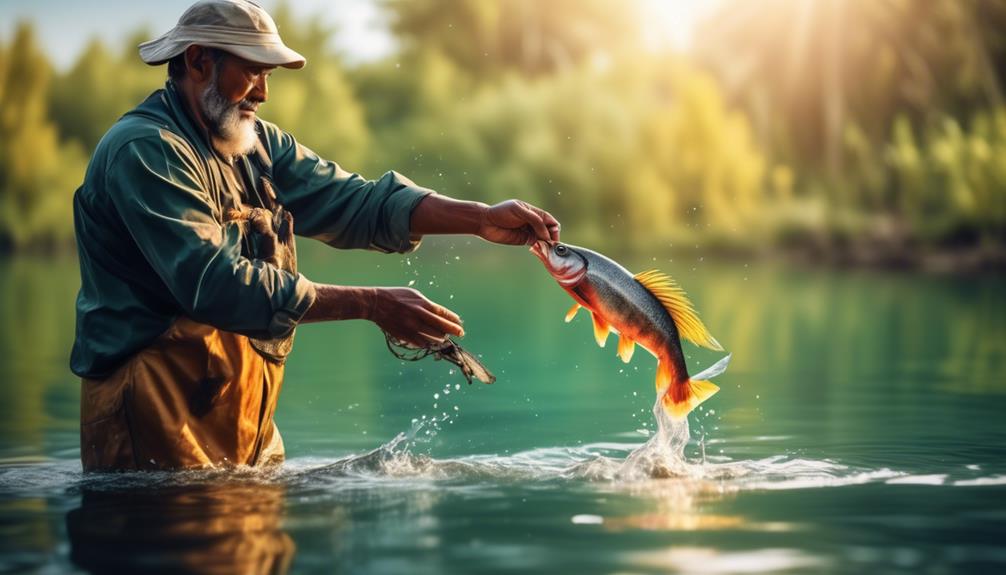
Enhancing your recreational fishing experience requires a deep respect for natural resources, ensuring their preservation for future generations. When it comes to catch and release ethics in tournaments, it's crucial to consider the impact on the environment and wildlife conservation. Here's why respect for natural resources is essential:
- Environmental Responsibility:
By practicing catch and release, you demonstrate environmental responsibility. Releasing fish back into their natural habitat helps maintain the delicate balance of the ecosystem. It minimizes the disruption caused by overfishing and promotes the sustainability of aquatic life.
- Preservation of Habitats:
Respect for natural resources involves preserving the habitats where fish thrive. Catch and release allows fish to continue their natural behaviors, contributing to the overall health of their habitats. This, in turn, supports the diverse array of wildlife that depends on these ecosystems.
- Minimization of Waste:
When you release fish, you minimize waste and reduce the impact on the environment. This aligns with the principles of environmental responsibility and ensures that natural resources aren't needlessly depleted.
- Long-Term Conservation:
Embracing catch and release as an ethical practice demonstrates a commitment to long-term wildlife conservation. By allowing fish to grow and reproduce, you contribute to the sustainability of fish populations, safeguarding them for future generations of anglers.
Contribution to Ecosystem Health
Practicing catch and release in tournaments actively contributes to the overall health of the ecosystem. By releasing fish back into their natural habitat, you're helping to maintain the ecological balance and preserve fish habitat. When fish are caught and immediately released, it minimizes the impact on their environment, allowing them to continue contributing to the food chain and maintaining biodiversity.
Fish play a crucial role in the food chain, and their presence is essential for the balance of aquatic ecosystems. By releasing fish back into the water, you're ensuring that they can fulfill their role in the food chain, contributing to the overall health and stability of the ecosystem. Additionally, releasing larger, more mature fish helps maintain the balance within fish populations, ensuring that there are enough breeding adults to sustain healthy population levels.
Furthermore, catch and release practices contribute to the preservation of fish habitat. Removing large numbers of fish from their natural environment can disrupt the delicate balance of aquatic ecosystems. By releasing fish, you're helping to maintain the biodiversity and overall health of the habitat, ensuring that the ecosystem remains intact for future generations of fish and other aquatic organisms.
Frequently Asked Questions
What Are the Potential Long-Term Effects of Catch and Release on the Genetic Diversity of Fish Populations?
When considering the potential long-term effects of catch and release on the genetic diversity of fish populations, it's important to acknowledge the impact it has on conservation efforts.
By practicing catch and release, you can help preserve genetic diversity within fish populations. This approach supports the sustainability of fish species and contributes to maintaining healthy ecosystems.
Conserving genetic diversity is crucial for the long-term survival of fish populations and supports overall environmental balance.
How Can Catch and Release Tournaments Ensure That Released Fish Are Able to Survive and Continue to Reproduce?
To ensure survival and reproduction sustainability in catch and release tournaments, proper handling techniques are crucial. Anglers should use barbless hooks, minimize air exposure, and avoid removing fish from the water.
Additionally, releasing fish in areas with suitable habitat and adequate food sources can increase their chances of survival and successful reproduction.
Are There Any Specific Guidelines or Regulations in Place to Prevent the Mishandling of Fish During Catch and Release Tournaments?
To ensure the survival and reproductive success of released fish in tournaments, regulations and handling techniques are crucial.
Specific guidelines are in place to prevent mishandling of fish, such as using barbless hooks, minimizing air exposure, and supporting fish in the water until they can swim away.
These measures contribute to higher survival rates and allow released fish to continue reproducing, maintaining the health of fish populations.
What Are the Economic Benefits of Promoting Catch and Release in Fishing Tournaments?
Promoting catch and release in fishing tournaments brings economic benefits by boosting eco-tourism, creating jobs, and sustaining local businesses.
Conservation impact is significant, as it helps preserve fish populations and maintain healthy ecosystems. When anglers release fish, it supports sustainable fisheries and ensures future generations can enjoy the sport.
Additionally, it enhances the overall fishing experience, attracting more participants and spectators, thus contributing to the local economy.
How Do Catch and Release Tournaments Contribute to the Overall Health and Balance of the Aquatic Ecosystem?
To contribute to aquatic conservation and ecosystem balance, catch and release tournaments play a crucial role.
By releasing fish back into their natural habitats, these tournaments help maintain healthy population levels and preserve the balance of aquatic ecosystems.
This practice also minimizes the impact on the environment and allows fish to continue playing their natural role in the ecosystem, ultimately supporting the overall health and sustainability of aquatic environments.
Conclusion
In conclusion, catch and release in tournaments is ethical because it helps preserve fish populations, mitigates environmental impact, promotes sustainable angling, and contributes to the overall health of ecosystems.
By practicing catch and release, anglers show respect for natural resources and contribute to the ethical treatment of wildlife. It's an important conservation practice that enhances recreational fishing while ensuring the long-term health and sustainability of fish populations and their habitats.
